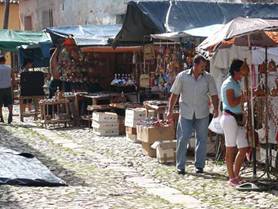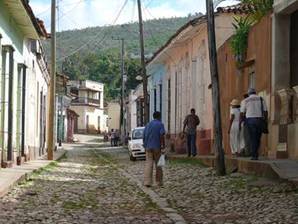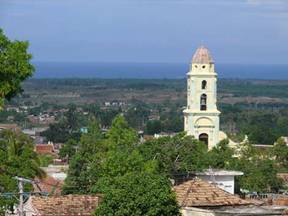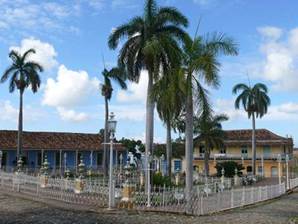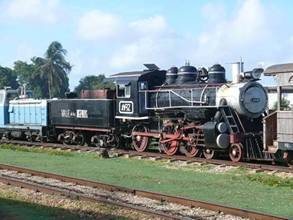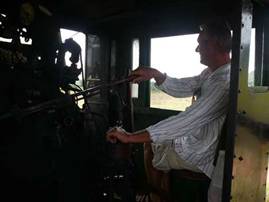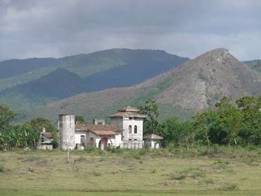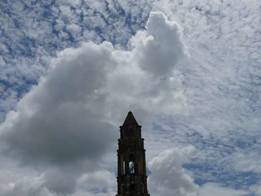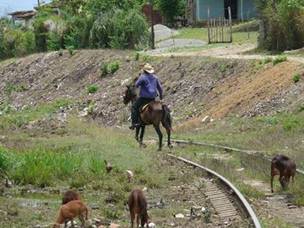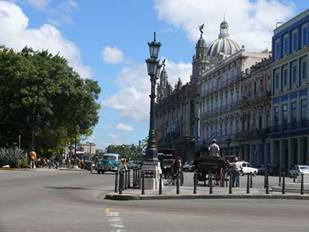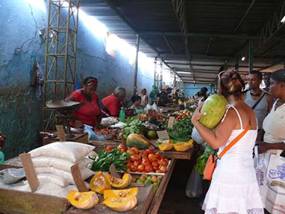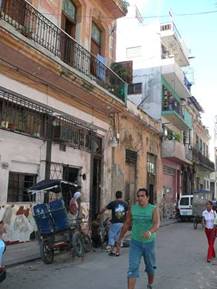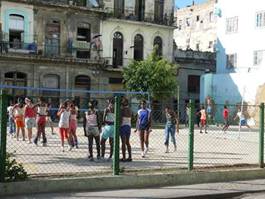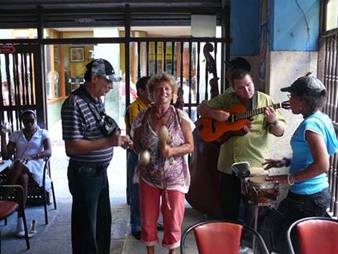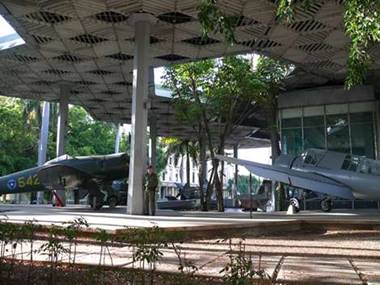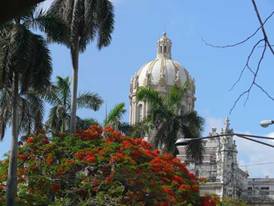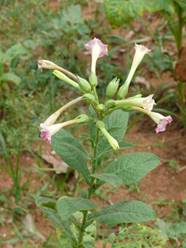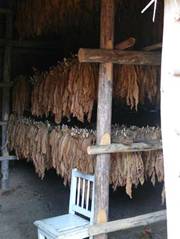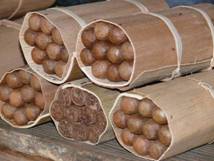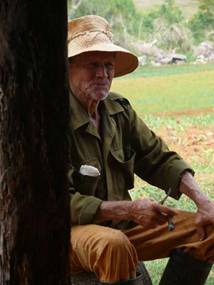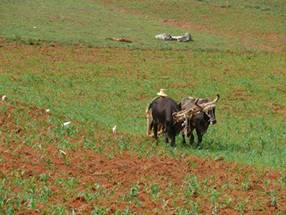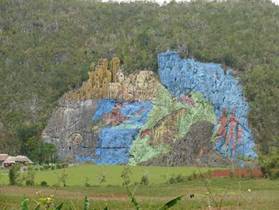INLAND CUBA 22:07.52N 80:27.16W

|
After 3 weeks of complete solitude it seemed strange to
be surrounded by people. Cienfuegos with its neoclassical architecture is clean
and by Cuban standards well maintained. Getting our bikes out of mothballs was
exciting and we enjoyed cycling. Our visa renewal was due 19th May.
25 Cuc stamps were required; the Marina had run out of 5 Cuc stamps. Being a
Saturday morning, the Banks were closed by 11 am. We offered to pay 30 Cuc but
that was refused (‘More than my job’s worth’). The Immigration officer reminded
us that if we were late renewing our visa the penalty was severe, by then we
realised one does not trifle with the system. We changed our plans and decided
to go to Trinidad for 3 days instead of Havana. We left Scorch in the Marina and
travelled inland. Trinidad was described in our book as The Little Gem of
Cuba whose architecture remains unspoilt (a term usually used for unrestored).
It has been designated as a UNESCO World Heritage Site. Our thoughts were if
this was the Gem, what was the rest like? It did not help arriving in pouring
rain. It grew on us and we did enjoy the music. Saturday evening the main square
was buzzing until 4 am with live music and Salsa dancing.
Bustling little market Typical
Trinidadian’s street
Old part of town It was our 1st encounter staying in a Casa
Particular (B & B) a very good way of finding out about people and Cuban
lifestyle. The government allows private householders to rent a room to
supplement their income. It decides the charge, according to standard and
location, usually 20 to 25 Cuc per room. The householder pays a monthly tax for
the privilege, whether he has customers or not and an annual income tax of about
10%. But the real income is on meals served where no tax is levied. Sunday morning we took the steam train to the next valley
and had a wonderful time.
Boys don’t
grow up, their toys get bigger! The countryside was very
pretty.
The old country ways still
apply. We returned to Cienfuegos in time to renew the visas.
We were going to Havana by bus but a French sailor’s wife
was returning to France and we managed to have a private car to take us. A cartel is operated by hustlers at the
bus station. A young lad, whose sister is married to an Italian and lives in
Italy and was home on a month’s visit, used her rented car to make some extra
income. Sadly joining a completely empty motorway from a fuel station without
stopping cost him 15 points on his licence (at least without a fine). After 35
points the licence is withdrawn for either 6 to 12 months depending on the
seriousness of the offences committed. Our B & B in Havana was good but the area was pretty
ram shackle; not the best first impression after a long tiring trip. In its hey day (1920/1930) Havana must have been amazing
and in a class of its own, with its fine museums, colonial buildings, elegant
plazas, sweeping boulevards and narrows atmospheric streets bustling with life.
Supported by rich Americans escaping prohibition. Today’s crumbling decay is pitiful to
see. Habana Vieje (Old City) a leafy district where many of the post colonial
mansions have been converted into public works and ministry offices or museums,
which have been beautifully restored, is proof of the majestic grandeur Havana
could be. Under the present regime,
which is now politically isolated from the rest of the world and has lost its
aid from Russia and China, there is no money left for restoration. Because all
housing is publicly owned there is no incentive for the inhabitants to maintain
the properties, and the decay continues. It would appear that Havana is a lost
cause
Volley Ball practice
Typical Havana back streets
Equally the old classic cars in poor state of repair
identify the remains of an old prosperous era. We are told that any Cuban is
allowed to own a car made before 1959. The other privately owned cars allowed
are Senior Government employees and wealthy Cubans who return from foreign
countries. Equally foreign firms, although since 10 years ago small foreign
investment is not allowed only large conglomerates.
We went to the National Theatre for a centenary concert.
It was wonderful. The tickets cost 20 Cuc for the tourists (the locals paid 5
Pesos, about 20p). The reduced rate applies for 3 months during the low season,
but very few took the opportunity. The Theatre was empty! The Orchestra was 40 strong; no string
instruments, only woodwind, brass and percussion. The singers were excellent.
The Grand piano was on its last legs. It was sad to see that even the National
Theatre could not afford a decent
instrument.
We visited the Museo de la Revolucion. It was a very
enlightening morning. Every street in Cuba has a CDR (Committee for the Defence
of the Revolution). They have meeting twice a month and everyone must attend, if
not they are investigated. It would seem to us that if the Revolution needs such
a strong defence it is probably not working. The youngsters, usually the hot bed
for dissent, are not contented. Cuba in its present form will have to change,
but so convinced are they that the present situation will last forever that we
are told it is not uncommon to hear people say that “IF Fidel dies”, rather than
“ WHEN”, things may change... When the change comes it will be painful and we
pray not too bloody.
Castillo de San Salvador
Capitolio National.
A replica of Washington’s Capitol
We are told Cuba has a very high divorce rate. It is near
impossible for a young married couple to have housing; therefore they share with
either parent, causing friction. To
walk away from marriage is easy; as people own nothing, they just pack a bag and
leave. 3 Days in Havana was enough, we moved on to Vinales, the
agricultural jewel of Pinar del Rio, with its extraordinary looking Mogotes
(limestone outcrops), where tobacco growing is the mainstay of agriculture. We
did a 20km hike. It reminded us of a wild west hick town, although pleasant it
did not come up to expectation. We visited a Cigar factory on the way. The most famous
Cohiba cigar leaves are apparently fermented for 10 years but not so the Monte
Cristo or Romeo and Juliet. It was fascinating to watch the process from the
leaf form to its rolling and its sophisticated and slick packaging to maintain
them in perfect condition. Not a sweaty thigh to be
seen!
Tobacco plant
Drying process Farmers wrap their cigars
In Royal
Palm leaves. We visited a local farmer grower. They are obliged to
sell 75% of their crop the Government. They keep 25% (the best of course!)
Unlike the Government owned farms, their crop is completely organically grown.
Their argument is that unlike a good wine which improves with maturing, leaves
do not. Therefore they dip their leaves in a mixture of water, honey, rum and
Guava leaves and after 5 days drying they make their cigars which they proudly
say are completely natural and the best. We can’t comment as neither of us
smoke!
Lovely
old farmer
Hoeing the old ways
The best way to get around If no prehistoric
paintings exists Paint some
1961 style! It was time to return to Scorch, but it was not without
its complications. We booked the micro bus direct to Cienfuegos on arrival, to
make sure we had seats. We were the first. It turned out that they had not
included our names and the bus was full. ‘Sorry, we will give you your money
back’ we stood firm and told them that it was their responsibility to gets us
back. After a lot of waiting and haggling we had a private taxi to take us on
our 6 hr. journey.
On our return we stocked up with fruit and vegetables and
decided the weather window was right to leave
Cuba. SYNOPSYS: Cuba is a sailor’s paradise with protected waters which
are crystal clear. There is no rubbish. On the deserted coral cays the only foot
prints are birds and reptiles. The Coral reefs and the marine life were amazing.
Inland Cuba is nothing to write home about but its appeal
is its people and music. The population of mixed race and colour live at peace
together. They are proud, very friendly, welcoming and on the surface appear
happy. They seem totally unresentful of the great advantages reserved for the
tourists, despite the restrictions and shortages caused by the American embargo.
They are very resourceful and look for ways to supplement their low income and
are not averse to fiddling the system if no one is watching. They are proud of
their education record and boast of the fact they have more doctors than
anywhere else in the world. In our view you cannot repress educated and
enquiring minds forever. There is so little reading material available.
Everything is censored. Very few computers and not for home consumption, the
system is archaic but we are told Chavez is installing an underwater optic fibre
cable from Venezuela to Cuba to improve internet access but no gift from Chavez
is without its price. Although the state incomes are very low, every citizen
lives in free housing and is issued with coupons for food and other basic
requirements which are almost free. This unique system where professional
qualification is paid so poorly and yet waiters and taxi drivers earn a relative
fortune does not smack of equality. This totally controlled social environment
kills personal initiative. It would
appear that even if they had a well rewarded post with the Government; retired
people find it very hard to manage and rely on subsidy from their family.
There are a huge number of Cubans living in America and
other countries. Their family in Cuba rely heavily on their financial help for
luxuries such as TV, washing machine etc. The Government decided few years ago
to tax any US$ by about 10%. Another form of income
tax. One could argue that there are flaws in both ‘socialist
and capitalist’ systems but the biggest different in our system is that we have
FREEDOM OF CHOICE as well as social responsibility.
Surely that must be the basic right of any human
being! The last person to board Scorch on leaving Cuba was the
Port Authority Officer; a delightful young man who belongs to a Cienfuegos Band.
He saw my guitar and sent us on our way with 3 songs. A perfect finale to our
stay
|
